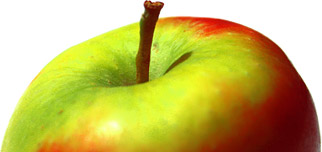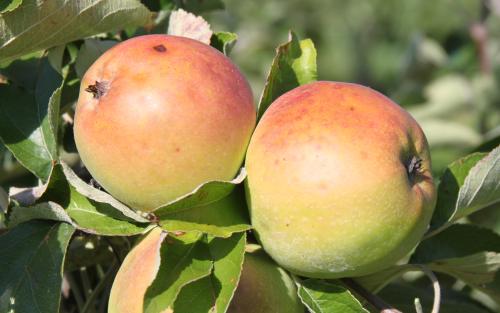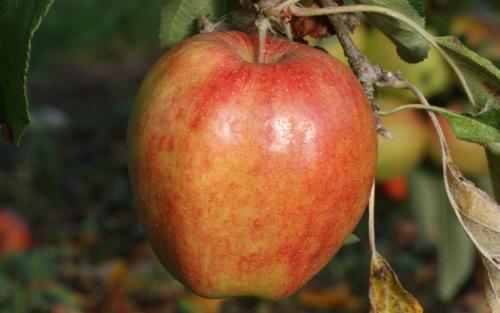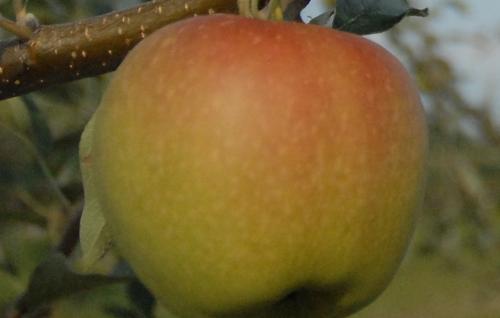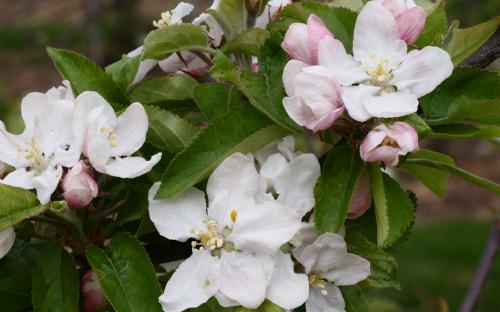Esopus Spitzenburg apple
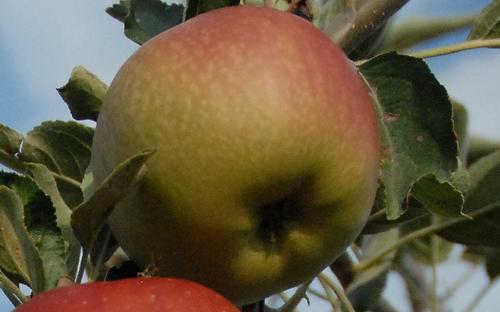
This highly respected American apple variety is named after the settlement of Esopus, Ulster County, New York, where it was found towards the end of the 18th century. It was rumoured to be Thomas Jefferson's favourite apple. It was widely planted in the USA in the 19th century and used for both dessert and culinary purposes, but subsequently fell out of fashion although it remains a popular variety for gardeners and trees are available from many US nurseries. The apples have an excellent flavor, which improves with storage.
Whilst American apple enthusiasts often seek out European (and especially English) heritage varieties, there is unfortunately little interest in American heritage varieties in Europe. It's apparent from the comments we get from visitors to this website that American and European tastes in apples are quite different, with Europeans apparently prefering slightly more complex flavours. However, if there was ever an American variety that should appeal to European tastes, it must be Spitzenberg. The flavour is truly aromatic and matches the complexity of the English aromatic apples. The flesh is a buttery dense yellow, and there is a rich sharpness which is often characteristic of high quality dessert apples. Eating a Spitzenberg is a thoroughly enjoyable experience. In terms of supermarket varieties, the closest match is probably Jazz, which also has similar dense flesh and rich sharp flavours.
It's unfortunate that some of the best flavoured apples are also the least reliable to grow (think Cox's Orange Pippin). Spitzenberg also falls into this category. One of our listed suppliers, Cummins Nursery, rates Spitzenberg as "susceptible to about all the common diseases". It is also relatively difficult to get hold of trees of this variety in Europe, although specialist suppliers may be able to graft to order. To make matters even worse, like many American varieties Spitzenberg needs good levels of sunshine and ripens quite late in the season - so northern European gardeners will need to find a sheltered south-facing wall for best results. However the effort is probably worth it, since Spitzenberg is a superb eating apple.
We are grateful to the Defra UK National Fruit Collection for tasting samples of this apple variety.
Esopus Spitzenburg apple identification images
All images copyright Orange Pippin unless otherwise stated.
USDA identification images for Esopus Spitzenburg
The identification paintings in the USDA Pomological Watercolor Collection span the years 1886 to 1942.
Citation: U.S. Department of Agriculture Pomological Watercolor Collection. Rare and Special Collections, National Agricultural Library, Beltsville, MD 20705.
Offspring of this variety
Visitor reviews
- 19 Aug 2023 Marilyn PomeroyWould love some advice on the best time to pick Should the apples reach a rosy color before you pick them? I mostly use mine for pies and apple butter. .
- 11 Dec 2022 James LyonI worked at a fruit stand in Oregon in my teens and the spitzenberg apple was the best I don't know where to get them in oregon
- 10 Apr 2019 Alan LagnadoSOUTH AUSTRALIA, AustraliaI have had good crops for a couple of years now, ripening in early-mid April here. Left on the tree for long enough they acquire a lovely aromatic burst when first crunched and colour up to a beautiful rich red. I've found the tree a little unruly but have had no problems with any diseases or infestations. In fact the tree is very strong and healthy on MM102 rootstock. Definitely one of the stand outs in my home orchard.
- 26 Oct 2015 Ashley O'SheaNJ, United StatesI have a Spitzenberg tree in my backyard, which produced a huge crop of apples this season. Although the apples are not very atheistically pleasing (which is probably why you do not often see them in stores), they are tart, juicy and quite delicious. They also keep for quite a long time after they have been picked. We have never treated our tree, as we garden organically, and have never had a problem with any disease, mites, scab, etc. (fingers crossed that we shall not in the future.) This tree is such a joy to have as part of our yard.
- 23 Apr 2014 JosephCA, United StatesI have grown the Spitz apple in my back yard for 40 years. I live in Sonoma County California and have never had any problems with it or any other varieties that I grow. It is a small apple but bears well and one of the best for pies. The flavor is to die for as long as the coddling moth does not infest the fruit. I use traps to attract the male moths which somewhat controls this problem. I would not be without this variety in my orchard.
- 11 Mar 2014 Will CarpenterINDIANA, United StatesMy favorite orchard, Spencer's Orchard in Upland Indiana carries the Esopus Spitzenberg. It is a phenomenal apple in taste, aroma, texture. I would grow it myself but this article is scaring me off.
- 26 Jan 2013 EdWASHINGTON, United StatesBeautiful, crisp, juicy, and complex flavor. Slightly tart, but not overpowering. Enjoyable to eat.
- 12 Nov 2012 M. ReedTX, United StatesJust tried a small organic Spitz from Kansas. Bright, clean, refreshing flavor. Nice balance of acid and sweetness. Darned good apple!
- 28 Sep 2012 Scott PetersonMA, United Statesi have newtown pippin which is ugly crunchy and have tried to grow esopus spitz. i have something that was supposed to be delbard, but does not look anything like it it looks like belle de boskoop, yl/brn russetted very large. anyones guess?
- 13 Oct 2011 Jean FritzIN, United StatesI grow this apple in my heirloom orchard. It ripens in late October in central Indiana, and I love to use it for cooking and juicing. When it is on the tree, it is one of the ugliest apples I've seen - it colors to a rusty orange - and it is prone to scab and fungal problems. The flavor of the fruit is exceptional, however, and my tree has been a very dependable producer for over 15 years.
- 20 Sep 2011 Phil BeanCA/ SONOMA, United StatesI obtained a bare-root standard Spitzenberg tree from the local Sonoma Antique Apple Nursery and planted it in the back yard in 1994. I performed minor tree surgery to rid it of borers a few times during about the first three years. More recently I have observed a few abnormal growths on or near the trunk (with a surface texture resembling broccoli), but I am not aware the 17-year-old tree has been affected by any of the diseases to which Spitzenberg is reported to be "highly susceptible." The tree now has a spread close to 30 feet and I can count on it to produce several hundreds of pound of apples from September through October. The crop is very "organic" -- riddled with worms -- presumably because I never seem to spray enough or pursue alternative measures to control white fly. Despite pestilence, I have been thoroughly spoiled by the Spitzenberg's exraordinary taste and must warn these apples can kill any interest whatsoever in most common store-bought varieties. The effect may be sudden and irreversible.
- 19 Sep 2011 Wendy WatsonCA, United StatesI discovered this apple by accident. Organically grown, locally, at the Sebastopol Whole foods. I made an apple pie with them that was out of this world. I believe these are my new favorite apple. What a happy discovery!
- 28 Jan 2011 GraceCA, United StatesI was curious about the Spitz after a strong rec from the (Philo) Apple Farm stand at the SF Ferry Plaza Sat market. They didn't have any to sell that day, but I managed to find them at Berkeley Bowl for a spell (right around Thanksgiving - Xmas). I peeled and sliced one and put it on some pastry crust, sprinkled a bit of sugar on it and baked it. The slices retain their shape but become wonderfully tender (not mushy). Outstanding flavor! I am completely smitten. Now they're gone from the Bowl but I'm hoarding a bag in my fridge. I hope people are right about how well it stores. I went to a fruit tree talk by a BA master gardener, and she also heaped praise on this fine apple. Now I can think of no other. . .
- 28 Oct 2010 JillOR, United StatesI grow this in my back yard. It fits all the descriptions above. I was wondering about this 60 year old tree. Can it be cloned? It's true about how it's a poor resister of disease, susceptible to sun burn, but it's large apples are good. All the wildlife flock to my yard to peck them and gleaners were especially keen to take home a lot. Leave them alone for 3 weeks after you pick in Oct before they're ready and they're sweeter that way good for several months.
- 01 Mar 2010 Dean FailorLINCOLN,OREGON, United StatesI obtained a Spitzenberg as the result of a grafting exercise in Master Gardners Class some years ago. It took about five years to mature to producing size in the Maritime climate I live in. (1/2 mile inland from the Pacific on the Central Oregon Coast) Even lacking cold hours this little tree produces great fruit.
- 11 Nov 2009 Andrew BellCAMBRIDGE, IOWA, United StatesSpitz makes the best applesauce in the world. It isn't hard to grow for me, but it doesn't bear heavily. It has taken a long time for them to come on after planting. The trees look spindly, but the fruit keeps well.
- 09 Nov 2009 JoelUnited States@ Mary from Boston The article mentions the difficulty in growing this apple: "It's unfortunate that some of the best flavoured apples are also the least reliable to grow (think Cox's Orange Pippin). Spitzenberg also falls into this category. One of our listed suppliers, Cummins Nursery, rates Spitzenberg as "susceptible to about all the common diseases"." I buy this apple from a farmer's market here in Seattle. It's wonderful. I hate the mild, mushy crap that is often sold in supermarkets. Spitzenberg is a great one.
- 23 Oct 2009 MaryBOSTON, United StatesFunny how the above mentioned people think this is the apple that should appeal to European tastes. Why? Because it does not mention that this is a VERY TOUGH VARIETY TO GROW UNLESS YOU ARE AN EXPERT GARDENER. According to a man I know who owns an orchard (not far from where Jefferson once lived I might add) Spitz is a pain in the butt to grow for the inexperienced because it is very sensitive. It MUST have water. It MUST be cared for 24/7. It is susceptible to diseases if not looked after carefully and it WILL die if you do not follow everything to the letter. As for the remark made above about Americans not liking so-called complex flavors, I say bah humbug. Personally I think the cowboys and farmers of old had it right the first time: "if my horse spits out the apple because it ain't got no juice or sweetness, I ain't eatin' it; if he nickers for more or tries to make juice foam on his lips, its time to holler for Ma and tell her we have a winner!"
- 23 Oct 2009 Bill SnotherlyNorth Carolina, United StatesI have purchased both a Spitzenburg and Newtown Pippin from Trees of Antiquity - from California. You might want to list them on the right. http://www.treesofantiquity.com/
- 06 Oct 2009 WillOAKLAND, CA, United StatesI just bought a Spitzenberg apple at the Ferry Building farmer's market in San Francisco. The vendor said he grows about six east coast heirloom-type varieties in Sonoma County (Northern Calif), which tends to be very sunny.
- 19 Sep 2009 JacquelineOREGON, United StatesWe grow these apples. Pears are our cash crop. However, the apples are our jewels!
- 31 Aug 2009 Holly IveyANAHEIM, ORANGE COUNTY/CALIFORNIA, United StatesI am an apple fanatic. For years I loved the tangy Pink Ladies until I discovered the Jazz variety sold at only one of the chain grocery stores (for a reasonable price). Now, any other variety is held up to the tart, complex crispness of jazz. The above noted similarities of the Jazz Apple to Spitzenburg's piques my curiosity. I have never seen these at the stores or farmer's market, nor have I ever heard of them until recent mention in the one page article in the past Sunday's Parade. Is there any source for this variety on the West Coast?
Tree register
United States
- Albany Appleguy in Castleton, NY
- Alex in Freeland, WA
- Andrew Plumer in Ashfield, MA
- angiehauri@yahoo.com in Westmoreland, NEW HAMPSHIRE
- Ann Donoghue in Fort Collins, CO
- Annie Oakes in SPOKANE, WA
- Axel Kratel in Santa Cruz, CALIFORNIA
- Ben in Helenwood, TN
- Brian Phillips in Saint Johns, MI
- Brian Van Erem in Green Bay, WI
- Carla Zimmerman in Oneida, WISCONSIN
- Catherine Simmons in Centralia, MO
- Chris in Kennewick, WA
- Chris Mastrangelo in Smithttown, NEW YORK
- Craig Engel in Viroqua, WI
- Csberch in TOLEDO, WA
- Dallin in Syracuse, UT
- Dallin in Syracuse, UT
- Dan Whitney in Cowiche, WA
- Daniel C in Sabetha, KANSAS
- Darren Peters in Rock Spring, GEORGIA
- Darren Peters in Rock Spring, GEORGIA
- Dave Beamer in Santa Barbara, CALIFORNIA
- Dave Dangelo in Augusta, MAINE
- David A Dawson in Solsberry, INDIANA
- David A Dawson in Solsberry, INDIANA
- David Horn in Purcellville, VIRGINIA/LOUDOUN
- Don Gaylord in Charlottesville, VA
- Don Mcivor in Twisp, WA
- Florian Deisenhofer in Brush Prairie, CLARK COUNTY WA
- Gary in Pleasant Hill, CA
- George Cochran in Maple City, MI
- Gina Colver in EPHRATA, WASHINGTON
- Harriette Jensen in Oakland, CALIFORNIA
- Helen Graben in Greenville, SC
- Herdie Baisden in Stockholm, WI
- Herdie Baisden in STOCKHOLM, WI
- Jady Morelli in Allendale, MI
- James Dierberger in Hebron, CT
- James Roden in Estacada, OR
- James Wargo in SOUTHBURY, CT
- Jarad Giese in Longmont, CO
- Jerry Hudgins in Point Reyes Station, CALIFORNIA
- Jon Shannon in Shaw Island, WA
- Jon Shannon in Shaw Island, WA
- Judd Curran in MISSOULA, MONTANA
- Katie Kranich in Elkton, MARYLAND
- Kevin Roe in Ames, IA
- Kurt in Ladysmith, WI - WISCONSIN
- Kurt in Ladysmith, WI - WISCONSIN
- Kurt in Ladysmith, WI - WISCONSIN
- Larry Landis in CORVALLIS, OREGON
- Libba Campbell in Albuquerque, NM
- Lorraine Leber in San Francisco, CA
- Mark A. Rock in Columbia Station, OHIO
- Mark Delman in Palo Alto, CALIFORNIA
- Marsha Hanchrow in Portland, OR
- Marshall Robert Crosby in Sugar Grove, NORTH CAROLINA
- Martin in Lakeport, CA
- Maryann in Elmhurst, IL
- Matthew in Pinon Hills, CA
- Michael Le Boulluec in Glen Rock, PA
- Mike in Glen Rock, PA
- Mike in Dayton, OH
- Mike Betts in Grattan Township, MICHIGAN/KENT
- Mike Prohaska in Lansing, MICHIGAN
- Nancy Crossley in Oxford, MICHIGAN
- Nathan Parker in Mount Shasta, CA
- Noah McVay in Spring Green, WISCONSIN
- Ollie Bucolo in Elmira, OREGON
- OrangePippin-Scott in Traverse City, MI
- Owen Witesman in SPRINGVILLE, UT
- Pat Conlin in SHELBURNE FALLS, MA
- Paul Grochowski in Floyd, VIRGINIA
- Phil Potter in Laguna Niguel, CALIFORNIA
- Randy Anderson in MONTICELLO, KY
- Richard Bock in Abiquiu, NM
- Richard Smith in Plymouth, MA
- Rick Simoniello in Storrs / Mansfield, CT
- Ricky Bruckner in RAVENNA, OHIO (OH)
- Rob in Ryegate, VT
- Robert Wallace in WESTMINSTER, VT
- Ron Davis in Chuckey, TN
- Ronald Wolfe in Monticello, ILLINOIS
- Ronny Blackstock in Fitzgerald, GA
- Rory Calhoun in Stafford, VA
- Ryan in Poway, CALIFORNIA
- Ryan Grover in Vineyard, UTAH
- Stephan Orchard in Westfield, INDIANA
- Stephen Mynhier in Fort Mill, SC
- Steven Stanley in Johnson City, TN
- Steven Sypkens in Turney, MO
- Susan in Fayetteville, NY
- Susan Abernathy in El Sobrante, CA
- Terry in Wappingers Falls, NY
- Terry Graham in Tumwater, WA
- Thomas Griffith in Cottage Grove, WI
- Tom & Diane Davidson in Salt Lake City, UTAH
- Tom Parks in Holladay, UT
- Trevor Roth in Erhard, MINNESOTA
- Velvie Mckenzie in Jackson, OH
- Victoria Else in Middletown, NY
- Wade in Omaha, NE
United Kingdom
- Nick Burrows in Helmsley, NORTH YORKSHIRE
Italy
- Ilario in Fossano, CUNEO
Netherlands
- Nynke Zijlstra in Eastermar, FRIESLAND
Canada
- Bill O'Keefe in Dobbinton, ONTARIO
- Erik Nordenson in Cobourg, ONTARIO
- Jeannine Caldbeck in Thetis Island, BRITISH COLUMBIA
- Rylan in COURTICE, ONTARIO
- v k Howald in Lucknow, ONTARIO
Australia
- Alan Lagnado in GAWLER EAST, SOUTH AUSTRALIA
- Hayden in Winslow, VICTORIA, AUSTRALIA
Spring blossom records for this variety
2020 season
- 26th April 2020 - tree owned by Jerry in Point Reyes Station, United States
- 23rd April 2020 - tree owned by Steven in Turney, United States
2019 season
- 29th April 2019 - tree owned by Ryan in Vineyard, United States
2017 season
- 27th April 2017 - tree owned by Noah in Spring Green, United States
- March 2017 - tree owned by Phil in Laguna Niguel, United States
2016 season
- 10th April 2016 - tree owned by Ilario in Fossano, Italy
- 15th March 2016 - tree owned by Phil in Laguna Niguel, United States
2015 season
- 30th April 2015 - tree owned by Michael in Glen Rock, United States
2014 season
- 26th April 2014 - tree owned by Rory in Stafford, United States
2013 season
- 6th April 2013 - tree owned by Libba in Albuquerque, United States
2012 season
- 9th May 2012 - tree owned by James in Estacada, United States
- 5th May 2012 - tree owned by Florian in Brush Prairie, United States
2011 season
- May 2011 - tree owned by v in Lucknow, Canada
Record your blossom dates in our Fruit Tree Register - more >>.
Harvest records for this variety
2020 season
- 3rd week October 2020 - tree owned by Jerry in Point Reyes Station, United States
2019 season
- 2nd week October 2019 - tree owned by Jon in Shaw Island, United States
2017 season
- September 2017 - tree owned by Phil in Laguna Niguel, United States
2013 season
- 4th week September 2013 - tree owned by Tom in Salt Lake City, United States
- 2nd week September 2013 - tree owned by Dave in Santa Barbara, United States
2011 season
Origins
- Species: Malus domestica - Apple
- Parentage: Unknown
- Originates from: Esopus, New York, United States
- Introduced: Early 1800s
- UK National Fruit Collection accession: 1950-033
- Some historical details taken with kind permission from 'The New Book of Apples' by Joan Morgan and Alison Richards , illustrated by Elisabeth Dowle, published by Ebury Press, 2002.
Identification
- Country of origin: United States
- Period of origin: 1800 - 1849
- Fruit colour: Orange / Red
- Leaf colour: Green
- Popularity: Best sellers
- Annual cycle: Deciduous
- Awards: Slow Food - Ark of Taste
Using
- Picking season: Late
- Keeping (of fruit): 3 months or more
- Flavour quality: Exceptional
- Flavour style (apples): Aromatic
- Discoloration of fruit: No discoloration (Good for drying)
- Cropping: Heavy
- Fruit persistence: Normal ripening
- Food uses: Eating fresh
- Food uses: Culinary
- Food uses: Juice
- Picking period: early October
- Wildlife: RHS Plants for Pollinators
Growing
- Gardening skill: Experienced
- Flowering group: 4
- Pollinating others: Average
- Ploidy: Diploid
- Vigour: Average vigour
- Bearing regularity: Biennial tendency
- Fruit bearing: Spur-bearer
- Self-fertility: Not self-fertile
Climate
- Cold hardiness (USDA): Zone 4 (-34C)
- Climate suitability: Temperate climates
- Climate suitability: Warm climates
- Summer average maximum temperatures: Cool ( 20-24C / 68-75F)
- Summer average maximum temperatures: Warm (25-30C / 76-85F)
- Summer average maximum temperatures: Hot (>30C / 86F)
Other qualities
- Disease resistance: Poor
- Cedar apple rust: Some susceptibility
- Canker: Very susceptible
- Scab (Apple and Pear): Very susceptible
- Fire blight: Very susceptible
Where to buy trees
The following tree nurseries offer Esopus Spitzenburg apple trees for sale:
- Orange Pippin Fruit Trees (USA) United States
Spitzenburg apple trees - Red Rock Orchards Ltd
Canada More >>
Where to buy fresh fruit
The following orchards grow Esopus Spitzenburg:
United States
California
- Denver Dan's, Camino
- The Apple Farm -- Bates & Schmitt, Philo
Colorado
- Ela Family Farms, Hotchkiss
- Gott Bro's Orchard & Produce, L.L.C., Ignacio
Connecticut
- Seek No Further Orchard, Hebron
Georgia
- Freedom Farms - Apple & Peach Orchard, Chatsworth
Iowa
- Wilson's Orchard, Iowa City
Kansas
- Fieldstone Enterprise, Overbrook
Kentucky
- Hidden Hollow Orchard and Wildlife Sanctuary, Louisville
- Reed Valley Orchard, Paris
Maine
- Tiny Orchards, Saco
Massachusetts
- Old Frog Pond Farm, Harvard
Michigan
- Alber's Orchard & Cider Mill, Manchester
- Christmas Cove Farm, Northport *** Feature Orchard ***
- KlineKrest USDA Certified Organic Produce Farm, Lyons
- Phillips Orchards & Cider Mill, Saint Johns
Minnesota
- Two Fruit's Fruits, Hinckley
Montana
New Hampshire
- Alyson's Apple Orchard, Walpole
New Mexico
- Von Bock Farm, Abiquiu
New York
- Albany Apple Guy:Purveyor of Rare & Exotic Apples, Castleton
- Bellinger's Apple Orchard, Fultonville
- Black Diamond Farm, Trumansburg
- Indian Ladder Farms Inc., Altamont
North Carolina
- Big Horse Creek Farm, Lansing
- Creasman Farms, Hendersonville
Oregon
- First Fruits, Independence
- Kiyokawa Family Orchards, Mount Hood Parkdale
- Old Stage Farm, Central Point
- Smith Berry Barn, Hillsboro
- B&P Hitz Fruit Farm, Woodburn
Pennsylvania
- Holy Root Farm, New Tripoli
- Northrop's Apple Acres, Lake City
Washington
- Piper's Orchard, Seattle
- Skipley Farm, Snohomish *** Feature Orchard ***
Wisconsin
- Cattleana Ranch, Poygan Township/Omro
- Door Creek Orchard, Cottage Grove
Canada
British Columbia
- Apple Luscious Organic Orchards, Salt Spring Island
- Salt Spring Apple Company, Salt Spring Island
Prince Edward Island
- Red Rock Orchards Ltd, Mount Buchanan
Australia
Victoria
- Heritage Fruits Society, Fairfield
References
- Apples for the 21st Century
Author: Manhart
Listed as Spitzenberg - Some Antique Apples for Modern Orchards, (2008)
Author: Merwin I.A.

